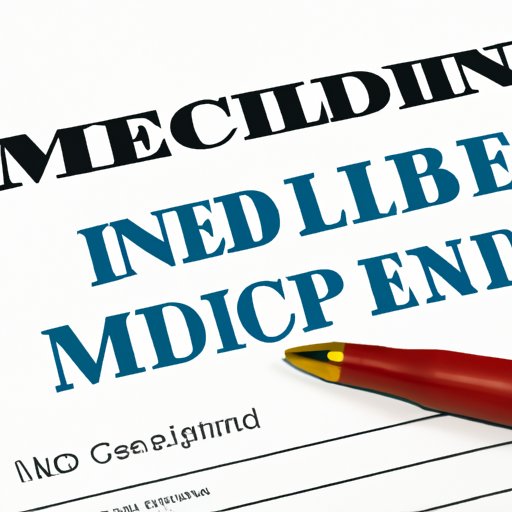
Introduction
Medicaid is a state and federal program that provides healthcare coverage for low-income individuals and families, as well as those with certain disabilities. It is an essential resource for millions of Americans who may not have access to healthcare otherwise. In this article, we will explore the eligibility requirements for Medicaid, the application process, the differences between Medicaid and Medicare, state-specific rules and requirements, and common myths about Medicaid. By the end of this comprehensive guide, you will have a better understanding of the program and how to navigate the enrollment process.
5 Simple Steps to Apply for Medicaid: A Comprehensive Guide
Applying for Medicaid can seem daunting, but there are steps you can take to make the process smoother. Firstly, you will need to gather the necessary documents, such as proof of income, residency, and citizenship or immigration status. Secondly, you can apply online, by phone, by mail, or in person, depending on your state’s requirements. It is crucial to ensure that your application is completed accurately and in full. In addition, you should follow up on the status of your application to ensure that it has been received and is being processed. This will help avoid any delays or issues that may arise during the enrollment process.
Who Qualifies for Medicaid? Understanding Eligibility Requirements
Medicaid eligibility criteria vary by state, but federal law sets some common minimum standards. Generally, eligibility is determined based on income, household size, and citizenship or immigration status. Some states may offer expanded coverage that includes individuals with slightly higher incomes, pregnant women, children, and those with certain disabilities. You can determine your eligibility by referring to your state’s Medicaid website or contacting your state’s Medicaid agency directly.
Medicaid vs. Medicare: Which One is Right for You?
While both Medicaid and Medicare provide healthcare coverage, there are significant differences between the two programs. Medicare is primarily intended for people over 65 years of age and those with certain disabilities, while Medicaid is designed for low-income individuals and families. Medicare is a federal program, while Medicaid is jointly funded by the federal and state governments. You can determine which program is right for you by comparing coverage, eligibility requirements, out-of-pocket costs, and other factors.
Getting Medicaid in Your State: What You Need to Know
Since each state administers Medicaid differently, it is essential to understand your state’s specific rules and requirements. Some states may offer expanded coverage, while others may have more stringent eligibility criteria. You can find information about your state’s Medicaid program on your state’s Medicaid website or by contacting your state’s Medicaid agency directly. It is crucial to keep in mind that enrollment procedures may vary from state to state, so it is essential to follow the process specific to your state.
Should You Use a Medicaid Enrollment Broker?
Medicaid enrollment brokers are entities that can help you navigate the enrollment process by providing information, answering questions, and assisting with your application. While using an enrollment broker can be helpful, there are pros and cons to consider. For example, a broker can help streamline the process, but there may be fees associated with using their services. It is essential to do research and find a reputable enrollment broker before utilizing their services.
Navigating Medicaid in Times of Crisis: What to Do If You Suddenly Lose Your Job and Health Insurance
If you lose your job and health insurance, you may be eligible for Medicaid coverage. Medicaid offers a program called “retroactive coverage,” which means that you can be covered for unpaid medical bills for up to three months before you enrolled in Medicaid. If you find yourself in this situation, it is crucial to act quickly and contact your state’s Medicaid agency to learn about your options and receive coverage as soon as possible to avoid incurring significant medical bills.
10 Common Myths About Medicaid Dispelled
There are many myths and misconceptions about Medicaid, which can prevent people from applying for coverage. Some of these misconceptions include that Medicaid is only for the unemployed, that Medicaid is low-quality care, and that Medicaid is only for people with children. However, these myths are not accurate, and it is essential to understand the truth about Medicaid. The program provides critical healthcare services to millions of Americans, and debunking common myths is necessary to encourage more people to enroll in the program.
Conclusion
Medicaid is a vital resource for millions of people in the United States, providing critical healthcare coverage to low-income individuals and families, as well as those with certain disabilities. By following the steps outlined in this article, you can determine your eligibility and navigate the enrollment process smoothly. Understanding the difference between Medicaid and Medicare, state-specific rules and requirements, and common myths about Medicaid is also crucial. We encourage you to act on your newfound knowledge and take advantage of this essential program to receive the healthcare coverage you need.





